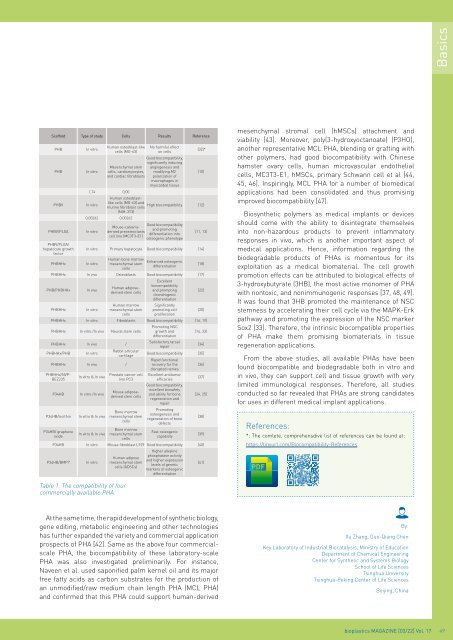Issue 03/2022
Highlights: Injection Moulding Beauty & Healthcare Basics: Biocompatibility of PHA Starch
Highlights:
Injection Moulding
Beauty & Healthcare
Basics:
Biocompatibility of PHA
Starch
Create successful ePaper yourself
Turn your PDF publications into a flip-book with our unique Google optimized e-Paper software.
Basics<br />
Scaffold Type of study Cells Results Reference<br />
PHB<br />
PHB<br />
PHBV<br />
PHBV/PLGA<br />
PHBV/PLGA/<br />
hepatocyte growth<br />
factor<br />
PHBHHx<br />
In vitro<br />
Human osteoblast-like<br />
cells (MG-63)<br />
No harmful effect<br />
on cells<br />
[32]*<br />
Good biocompatibility,<br />
significantly inducing<br />
In vitro<br />
Mesenchymal stem<br />
cells, cardiomyocytes,<br />
angiogenesis and<br />
modifying M2<br />
[10]<br />
and cardiac fibroblasts polarization of<br />
macrophages in<br />
myocardial tissue<br />
1,74 0,00<br />
Human osteoblastlike<br />
In vitro<br />
cells (MG-63) and<br />
High biocompatibility<br />
murine fibroblast cells<br />
[12]<br />
(NIH-3T3)<br />
0,00262 0,00262<br />
In vitro<br />
Good biocompatibility<br />
Mouse-calvariaderived<br />
preosteoclasts<br />
and promoting<br />
differentiation into<br />
cell line (MC3T3-E1)<br />
osteogenic phenotype<br />
[11, 13]<br />
In vitro Primary hepatocyte Good biocompatibility [14]<br />
In vitro<br />
Human bone marrow<br />
mesenchymal stem<br />
cells<br />
Enhanced osteogenic<br />
differentiation<br />
PHBHHx In vivo Osteoblasts Good biocompatibility [17]<br />
PHB/PHBHHx<br />
PHBHHx<br />
In vivo<br />
In vitro<br />
Human adiposederived<br />
stem cells<br />
Human marrow<br />
mesenchymal stem<br />
cells<br />
Excellent<br />
biocompatibility<br />
and prompting<br />
chondrogenic<br />
differentiation<br />
Significantly<br />
promoting cell<br />
proliferation<br />
PHBHHx In vitro Fibroblasts Good biocompatibility [16, 19]<br />
PHBHHx In vitro /In vivo Neural stem cells<br />
Promoting NSC<br />
growth and<br />
[14, 33]<br />
differentiation<br />
PHBHHx In vivo /<br />
Satisfactory tarsal<br />
repair<br />
[34]<br />
PHBHHx/PHB In vitro<br />
Rabbit articular<br />
cartilage<br />
Good biocompatibility [35]<br />
PHBHHx In vivo /<br />
Rapid functional<br />
recovery for the<br />
disrupted nerves<br />
[36]<br />
PHBHHx/NVP-<br />
BEZ235<br />
P34HB<br />
P34HB/lecithin<br />
P34HB/ graphene<br />
oxide<br />
In vitro & In vivo<br />
In vitro /In vivo<br />
In vitro & In vivo<br />
In vitro & In vivo<br />
Prostate cancer cell<br />
line PC3<br />
Mouse adiposederived<br />
stem cells<br />
Bone marrow<br />
mesenchymal stem<br />
cells<br />
Bone marrow<br />
mesenchymal stem<br />
cells<br />
Excellent antitumor<br />
efficacies<br />
Good biocompatibility,<br />
excellent biosafety<br />
and ability for bone<br />
regeneration and<br />
repair<br />
Promoting<br />
osteogenesis and<br />
regeneration of bone<br />
defects<br />
Fast osteogenic<br />
capability<br />
[18]<br />
[22]<br />
[20]<br />
[37]<br />
[24, 25]<br />
P34HB In vitro Mouse fibroblast L929 Good biocompatibility [40]<br />
P34HB/BMP7<br />
In vitro<br />
Human adipose<br />
mesenchymal stem<br />
cells (ADSCs)<br />
Higher alkaline<br />
phosphatase activity<br />
and higher expression<br />
levels of genetic<br />
markers of osteogenic<br />
differentiation<br />
[38]<br />
[39]<br />
[41]<br />
mesenchymal stromal cell (hMSCs) attachment and<br />
viability [43]. Moreover, poly(3-hydroxyoctanoate) (P3HO),<br />
another representative MCL PHA, blending or grafting with<br />
other polymers, had good biocompatibility with Chinese<br />
hamster ovary cells, human microvascular endothelial<br />
cells, MC3T3-E1, hMSCs, primary Schwann cell et al [44,<br />
45, 46]. Inspiringly, MCL PHA for a number of biomedical<br />
applications had been consolidated and thus promising<br />
improved biocompatibility [47].<br />
Biosynthetic polymers as medical implants or devices<br />
should come with the ability to disintegrate themselves<br />
into non-hazardous products to prevent inflammatory<br />
responses in vivo, which is another important aspect of<br />
medical applications. Hence, information regarding the<br />
biodegradable products of PHAs is momentous for its<br />
exploitation as a medical biomaterial. The cell growth<br />
promotion effects can be attributed to biological effects of<br />
3-hydroxybutyrate (3HB), the most active monomer of PHA<br />
with nontoxic, and nonimmunogenic responses [37, 48, 49].<br />
It was found that 3HB promoted the maintenance of NSC<br />
stemness by accelerating their cell cycle via the MAPK-Erk<br />
pathway and promoting the expression of the NSC marker<br />
Sox2 [33]. Therefore, the intrinsic biocompatible properties<br />
of PHA make them promising biomaterials in tissue<br />
regeneration applications.<br />
From the above studies, all available PHAs have been<br />
found biocompatible and biodegradable both in vitro and<br />
in vivo, they can support cell and tissue growth with very<br />
limited immunological responses. Therefore, all studies<br />
conducted so far revealed that PHAs are strong candidates<br />
for uses in different medical implant applications.<br />
References:<br />
*: The comlete, comprehensdive list of references can be found at:<br />
https://tinyurl.com/Biocompatibility-References<br />
Table 1. The compatibility of four<br />
commercially available PHA.<br />
At the same time, the rapid development of synthetic biology,<br />
gene editing, metabolic engineering and other technologies<br />
has further expanded the variety and commercial application<br />
prospects of PHA [42]. Same as the above four commercialscale<br />
PHA, the biocompatibility of these laboratory-scale<br />
PHA was also investigated preliminarily. For instance,<br />
Naveen et al. used saponified palm kernel oil and its major<br />
free fatty acids as carbon substrates for the production of<br />
an unmodified/raw medium chain length PHA (MCL PHA)<br />
and confirmed that this PHA could support human-derived<br />
By:<br />
Xu Zhang, Guo-Qiang Chen<br />
Key Laboratory of Industrial Biocatalysis, Ministry of Education<br />
Department of Chemical Engineering<br />
Center for Synthetic and Systems Biology<br />
School of Life Sciences<br />
Tsinghua University<br />
Tsinghua-Peking Center of Life Sciences<br />
Beijing, China<br />
bioplastics MAGAZINE [<strong>03</strong>/22] Vol. 17 49

















